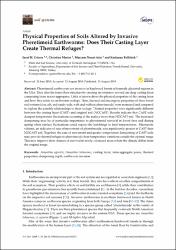| dc.contributor.author | Gorres, Josef Hubert | |
| dc.contributor.author | Martin, Christina | |
| dc.contributor.author | Nouri-Aiin, Maryam | |
| dc.contributor.author | Bellitürk, Korkmaz | |
| dc.date.accessioned | 2022-05-11T14:46:06Z | |
| dc.date.available | 2022-05-11T14:46:06Z | |
| dc.date.issued | 2019 | |
| dc.identifier.issn | 2571-8789 | |
| dc.identifier.uri | https://doi.org/10.3390/soilsystems3030052 | |
| dc.identifier.uri | https://hdl.handle.net/20.500.11776/10228 | |
| dc.description.abstract | Pheretimoid earthworms are invasive in hardwood forests of formerly glaciated regions in the USA. They alter the forest floor structure by creating an extensive, several cm-deep casting layer comprising loose macro-aggregates. Little is known about the physical properties of the casting layer and how they relate to earthworm ecology. Here, thermal and macropore properties of three forest soil textures (clay, silt, and sandy soils, with and without pheretimoids) were measured and compared to explore the possible relationships to their ecology. Thermal properties were significantly different between the casting layer (CAST) and original soil (NOCAST). Results indicate that CAST soils dampen temperature fluctuations occurring at the surface more than NOCAST soil. The increased dampening may be of particular importance to pheretimoid survival in forest fires and during spring when surface fluctuations could expose the hatchlings to fatal temperatures. Macropore volume, an indicator of ease of movement of pheretimoids, was significantly greater in CAST than NOCAST soil. Together, the ease of movement and greater temperature dampening of CAST soils may provide thermal refuges to pheretimoids from temperature variations outside the optimal range. This may improve their chances of survival in newly colonized areas where the climate differs from the original range. | en_US |
| dc.description.sponsorship | University of Vermont's Agricultural Research Station [1018366]; Turkish Scientific and Technological Research Council, TUBITAKTurkiye Bilimsel ve Teknolojik Arastirma Kurumu (TUBITAK) [2219] | en_US |
| dc.description.sponsorship | This research was funded by The University of Vermont's Agricultural Research Station (Hatch 1018366) and the Turkish Scientific and Technological Research Council, TUBITAK (International Post-Doctoral Research Fellowship 2219). | en_US |
| dc.language.iso | eng | en_US |
| dc.publisher | Mdpi | en_US |
| dc.identifier.doi | 10.3390/soilsystems3030052 | |
| dc.rights | info:eu-repo/semantics/openAccess | en_US |
| dc.subject | Amynthas agrestis | en_US |
| dc.subject | Amynthas tokioensis | en_US |
| dc.subject | casting layer | en_US |
| dc.subject | inter-aggregate pores | en_US |
| dc.subject | thermal properties | en_US |
| dc.subject | dampening depth | en_US |
| dc.subject | earthworm invasion | en_US |
| dc.subject | Genus Amynthas Kinberg | en_US |
| dc.subject | Hardwood Forest | en_US |
| dc.subject | Agrestis | en_US |
| dc.subject | Temperature | en_US |
| dc.subject | Metaphire | en_US |
| dc.subject | Moisture | en_US |
| dc.subject | Density | en_US |
| dc.subject | Cocoons | en_US |
| dc.title | Physical Properties of Soils Altered by Invasive Pheretimoid Earthworms: Does Their Casting Layer Create Thermal Refuges? | en_US |
| dc.type | article | en_US |
| dc.relation.ispartof | Soil Systems | en_US |
| dc.department | Fakülteler, Ziraat Fakültesi, Toprak Bilimi ve Bitki Besleme Bölümü | en_US |
| dc.authorid | 0000-0003-4944-3497 | |
| dc.identifier.volume | 3 | en_US |
| dc.identifier.issue | 3 | en_US |
| dc.institutionauthor | Bellitürk, Korkmaz | |
| dc.relation.publicationcategory | Makale - Uluslararası Hakemli Dergi - Kurum Öğretim Elemanı | en_US |
| dc.authorscopusid | 7003754349 | |
| dc.authorscopusid | 57219728732 | |
| dc.authorscopusid | 57200270161 | |
| dc.authorscopusid | 35811876500 | |
| dc.authorwosid | Belliturk, Korkmaz/AAE-2366-2022 | |
| dc.authorwosid | Belliturk, Korkmaz/ABA-1887-2020 | |
| dc.authorwosid | Gorres, Josef/AAG-8178-2020 | |
| dc.identifier.wos | WOS:000492988900016 | en_US |
| dc.identifier.scopus | 2-s2.0-85090226220 | en_US |



















